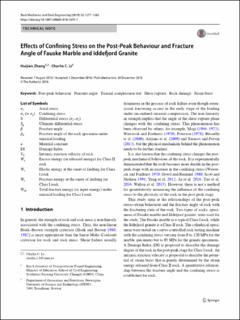| dc.description.abstract | In general, the strength of rock and rock mass is non-linearly associated with the confining stress. Thus, the non-linear Hoek–Brown strength criterion (Hoek and Brown 1980, 1982) is more appropriate than the linear Mohr–Coulomb criterion for rock and rock mass. Shear failure usually dominates in the process of rock failure even though extensional fracturing occurs in the early stage of the loading under unconfined uniaxial compression. The non-linearity in strength implies that the angle of the shear rupture plane changes with the confining stress. This phenomenon has been observed by others, for example, Mogi (1966, 1971), Wawersik and Fairhurst (1970), Paterson (1978), Bésuelle et al. (2000), Alejano et al. (2009) and Tarasov and Potvin (2013), but the physical mechanism behind the phenomenon needs to be further studied.
It is also known that the confining stress changes the post-peak mechanical behaviour of the rock. It is experimentally demonstrated that the rock becomes more ductile in the post-peak stage with an increase in the confining stress (Wawersik and Fairhurst 1970; Gowd and Rummel 1980; Scott and Nielsen 1991; Yang et al. 2012; Ai et al. 2016; Yao et al. 2016; Walton et al. 2015). However, there is not a method for quantitatively measuring the influence of the confining stress to the plasticity of the rock in the post-peak stage.
This study aims at the relationships of the post-peak stress–strain behaviour and the fracture angle of rock with the fracturing state of the rock. Two types of rocks, specimens of Fauske marble and Iddefjord granite, were used for the study. The Fauske marble is a typical Class I rock, while the Iddefjord granite is a Class II rock. The cylindrical specimens were tested on a servo-controlled rock testing machine with the confining stress varying from 0 to 120 MPa for the marble specimens but to 85 MPa for the granite specimens. A Damage Index (DI) is proposed to describe the damage degree of the rock in the post-peak stage for Class I rock. An intrinsic ejection velocity is proposed to describe the potential of strain burst that is purely determined by the strain energy released from Class II rock. A quantitative relationship between the fracture angle and the confining stress is established for rock. | en_US |

